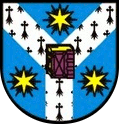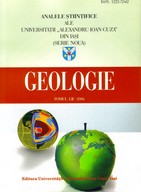
English title
- SERIA
GEOLOGIE (AUI-G) - |

|
| Log in New account |
| Home | Main Page | Guide for Authors | Peer Review | New Articles | Events | Archive | Index | Contact us |

|
Article PALYNOFACIES AND TOTAL ORGANIC CARBON CONTENT FROM THE BAIA BOREHOLE (MOLDAVIAN PLATFORM)
GABRIEL CHIRILĂ - “Al. I. Cuza” University of Iaşi, Faculty of Geography and Geology, Department of Geology, 20A Carol I Blv., 700505 Iaşi, Romania DANIEL ŢABĂRĂ - “Al. I. Cuza” University of Iaşi, Faculty of Geography and Geology, Department of Geology, 20A Carol I Blv., 700505 Iaşi, Romania View abstract as pdf file | View full article as pdf file Abstract: The studied borehole is located near the city of Fălticeni, in the western part of the
Moldavian Platform. The lithology consists of sands/sandstone, claystone and shale. In the
present study, for the interpretation of the palynofacies, 16 samples from the Baia borehole,
collected at depths between 290 and 1050 m, have been analyzed. For the analysis of the
Total Organic Carbon (TOC), 10 samples were prepared and analyzed. For most of the
samples, the results for the hydrocarbon potential vary from fair to good. In order to
establish the type of kerogen, 4 samples were studied and the H/C and O/C ratios were
calculated and plotted in a van Krevelen diagram. The type of kerogen resulted is III. The
samples analyzed for the study of the palynofacies mostly belong to field III, according to
the Tyson (1995) diagram. This field is characterized by a predominance of phytoclasts,
which indicate a fluvial-deltaic source where the palynomorphs are fairly preserved.
Amorphous Organic Matter (AOM) is present in low percentage. The color of the
sporomorphs in fluorescent light is yellow, which corresponds to a λ ≈ 580 nm wavelength.
The same color was noticed for the AOM studied in fluorescent light. Keywords: Baia locality, Moldavian Platform, palynofacies, kerogen, TOC |
copyright © 2024 Department of Geology |